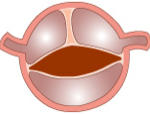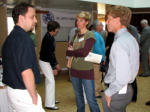


Disclaimer Privacy Policy
Copyright (c) 2021 Bicuspid Aortic Foundation, All Rights Reserved


Creating a Climate of Hope, an Atmosphere of Caring, and Information for All

Bicuspid Aortic Valve
Open BAV
The opening of a BAV resembles the open mouth of a fish, leading to the term “fish mouth” valve.
Some Common Questions about BAV
Can BAV be found just by looking at someone?
By just looking, it is not possible to tell if someone has this
condition. Unlike some other connective tissue disorders,
there are no strikingly obvious outward characteristics of
this disease. Those with BAV may be short, average in
height, or tall. They may have a slight, average, or large
body size.
Listening to their chest sometimes provides an important
clue. If the blood makes an unusual sound as it flows
through the bicuspid aortic valve, this sound or heart
murmur can be heard. However, blood may also flow
quietly through the bicuspid aortic valve, without a
murmur.
Many people with BAV are good athletes and enjoy
exercise and work outs at the gym. It is understandably
difficult for those who have BAV to reconcile this
contradiction in their body: strong, healthy muscles and
flexible joints along with a defective aortic valve and very
fragile aortic tissue.
Is Bicuspid Aortic Valve inherited?
This condition also appears to be inherited within families,
although not everyone in a family will have it. It is
important to consider the entire family when one person is
found to have a BAV. Since it may not be found early in life
or appear in every generation, going beyond the
immediate family (father, mother, brothers, sisters) to
include grandchildren, nieces, nephews, and cousins
when checking for BAV is wise.
Historically, the bicuspid aortic valve has been the main
identifier of this form of aortic disease. However, as entire
families are studied, thoracic aortic aneurysms and aortic
dissection have been found in family members with
normal appearing trileaflet aortic valves. The following
abstract, published in 2007, documents this:
Familial thoracic aortic dilation and bicommissural aortic
valve: a prospective analysis of natural history and
inheritance, Loscalzo ML, Goh DL, Loeys B, Kent KC,
Spevak PJ, Dietz HC, Am J Med Genet A. 2007 Sep
1;143A(17):1960-7
When did they get this?
It is a condition present at birth.
It was there when they were born, although it may not
have affected them until years later. Something happened
before birth, as their hearts, blood vessels, and other parts
of their bodies were forming.
Within the cells of the body, exactly what happened, why it
happened, and what currently is happening remain open
questions.
Genetic studies are currently underway in various centers,
seeking to understand the origin. Much more research is
needed. However, today we recognize and have treatment
for the most potentially devastating aspects of this
disease: bicuspid aortic valve failure, possible failure of
the mitral or other heart valves, aortic aneurysm, aortic
dissection, and brain aneurysm.
Medical and surgical advances have extended the lives of
those with bicuspid aortic disease. As they live longer, it is
not known if and how this condition will continue to
progress. Follow up care from experts is needed
throughout their lives.
BAV ranges from those who may live their entire life
without ever knowing they have it, to those who need a
procedure in infancy for severe narrowing of their bicuspid
aortic valve. These are the two extremes. In between are
those who will need some variation of the following:
• their aortic valve repaired or replaced
• some part of their thoracic aorta replaced - most often
the ascending aorta
• repair of coarctation of the aorta
• other procedures, such as repair or replacement of their
mitral valve
• treatment for brain aneurysm or dissection of head and
neck vessels
Research has begun on those with BAV who also develop
complications of the head and neck vessels: brain
aneurysms and dissection of head and neck vessels.
Some day, research will unlock the mysteries of this
condition. But for now, since it is still not fully
understood, it is important to keep an open mind
regarding this condition and its affects on families
who have it.
How is Bicuspid Aortic Valve Found in Families?
Often, it is first identified when a bicuspid aortic valve is
found in a family member, putting the entire family on
alert. Sometimes an ascending aortic aneurysm is
detected, and as this is being investigated, a bicuspid
aortic valve is also noticed. The aorta, as well as the aortic
valve and other heart valves, all are evaluated as part of
the screening for this condition.
Echocardiography, which creates images of the heart with
sound waves, is often the first test done that identifies a
bicuspid aortic valve. This may be done because a heart
murmur has been heard, or because there is another
reason to evaluate the heart valves and chambers. The
ascending aorta may also be imaged this way, and any
enlargement noted. Echocardiography does not always
detect a bicuspid aortic valve, especially if the fusion of
the leaflets is subtle. It often does not include the
ascending aorta. MRI or CT provide a complete look at the
aorta.
CT or MRI scans are used to obtain the most accurate
images of the aorta. A spiral CT scan with contrast or an
MRI both produce images of the entire aorta. MRI
technology is advancing rapidly and some centers now
have expertise that allow imaging of the heart valves and
heart as well as the aorta.
In addition, it is not known how many people who are
blood relatives of someone with an obvious BAV
suffer aortic aneurysm or dissection.

Bicuspid Aortic Valve
Closed BAV
When closed, it may be difficult to distinguish a BAV from an aortic valve with all three leaflets.
BAV and Athletes
It is very possible that
someone with BAV is
present at sporting events
of all kinds. Many of them
are serious athletes.

BAV is Common
It is very likely that you
know someone with BAV.
It could even exist in your
family or extended family
without you knowing about
it.


- Aorta
- BAV and Other Heart Valves
- Blood Pressure
- Exercise/Weight Lifting
- Featured Papers
- Guidelines
- Familial TAAD
- History
- Honoring Dr. M.E. Abbott
- Pictures (graphic content)
- Pictures Valvular Strand, Aneurysm (graphic)
- Prosthetic Heart Valves
- Scientific Awards
- Spotlight on Research - Coming Soon
- Video (graphic content)





































